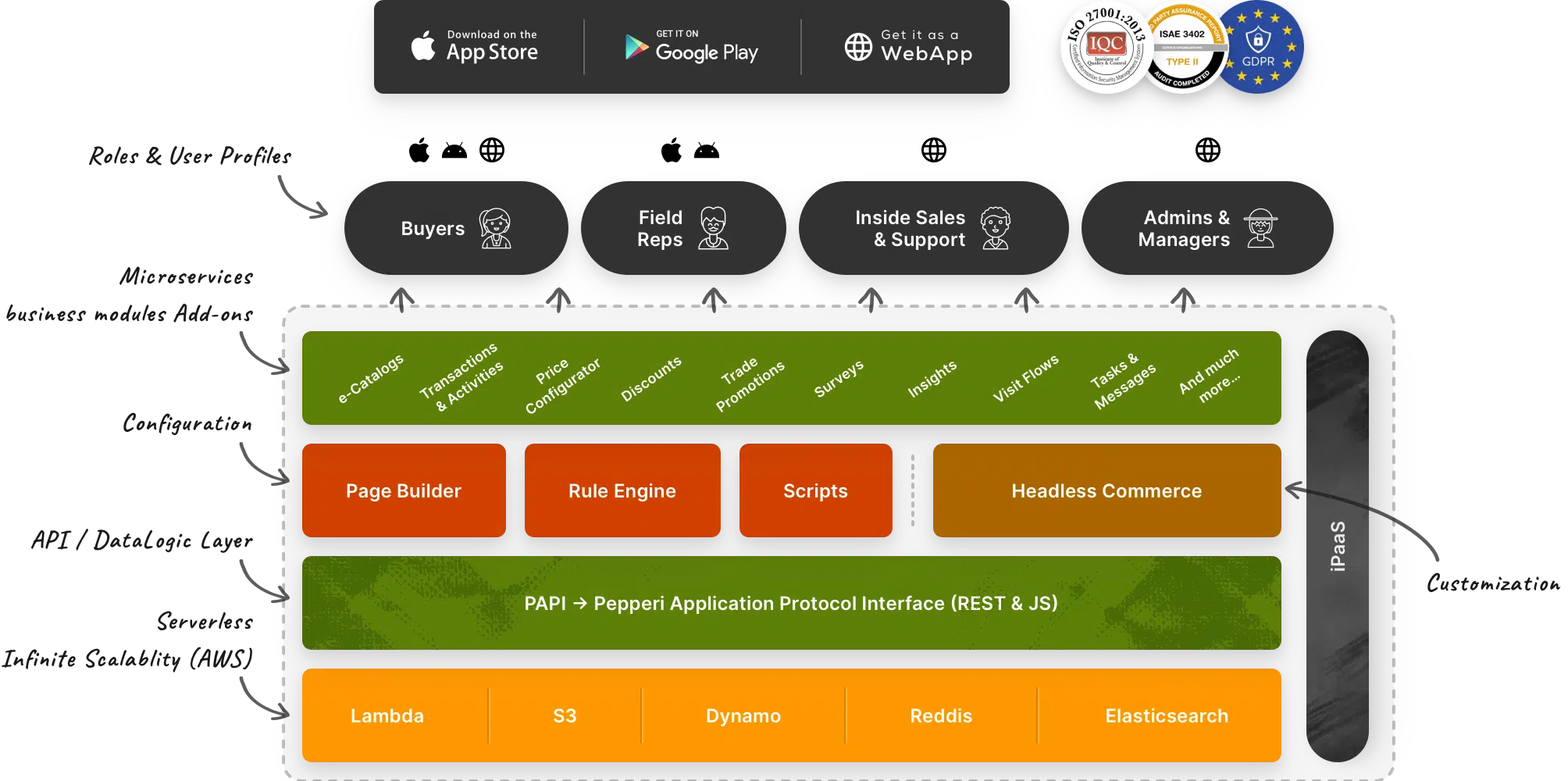What is Unified Commerce? Why It Has Taken Over B2B
January 31, 2023 By Yana Persky

Sales Channel Evolution
In today’s world, the way businesses transact has changed significantly. As technology advances, wholesalers are now offering buyers the convenience of shopping through multiple sales channels. However, it has proven to be a difficult endeavor, as the channels often function independently and not in coordination with one another. In this blog post, we will explore the evolution of sales channels, the challenges associated with multichannel and omnichannel commerce solutions and the trend of unified commerce.
The Birth of Multi-Channel Sales
In the past few decades, businesses have seen an explosion in the number of channels through which they can sell their products and services. Prior to this development, most sales took place through one primary channel. However, as technology advanced and consumers became more connected, businesses began to explore new channels to reach their customers.
One of the earliest examples of this was the move towards multichannel sales. Multichannel sales allowed companies to offer their products through different channels such as in-person, online portal, and call center. This enabled them to access new customer segments and markets that were previously inaccessible.
McKinsey reports that B2B companies that enabled purchase over more channels grew market share at a faster rate than those that relied on a single sales channel. While this strategy was initially met with success, it created several challenges for businesses.
The Challenge of Multi-Channel Sales
The challenge with multi-channel sales is that it requires wholesalers to operate each channel independently, which can be both time consuming and costly. In addition, since the channels are not integrated, they are unable to take advantage of features such as cross-selling, upselling, and other automated processes. This can lead to a fragmented customer experience, making it difficult for customers to find what they need or have their questions answered in a timely manner.
Furthermore, multi-channel sales often lack an efficient way to manage inventory levels across channels. Without integrated systems, each channel must be managed separately, creating opportunities for overstocking or understocking products. This leads to higher costs and dissatisfied customers due to out-of-stock items or long wait times for delivery.
Finally, multi-channel sales do not provide wholesalers with data insights. This means that they are unable to make data-driven decisions based on customer purchasing behavior across multiple channels.
For these reasons, many distributors have sought to move away from multi-channel sales and implement an omnichannel commerce solution.
The Move to Omnichannel Sales
As companies continued to grow and evolve, many began to realize that relying on multiple sales channels was not sustainable. They needed a better way to manage their sales operations, and so the concept of “omnichannel” was born.
The idea behind omnichannel was to create an integrated system that would coordinate all of a company’s different sales channels into one single platform. This would make it easier for customers to interact with the brand, and it would also reduce the costs associated with maintaining multiple platforms. Unfortunately, this goal of integrating multiple channels failed.
The primary reason for this failure was because many businesses failed to take back-office processes into account when planning their omnichannel strategy. Back-office operations are managed in multiple different tools and platforms, and trying to integrate them all can be challenging. Even if a business succeeds in setting up multiple custom integrations, they often do not truly communicate with each other. This can lead to mistakes and inconsistencies in data, resulting in added cost and time in order to maintain accuracy.
Unified Commerce Definition
Unified Commerce is defined as one single B2B Commerce platform that connects all front-end channels and backend systems, using the same business logic, and serves as an end-to-end solution for all sales-related functions.
Unified commerce is the latest trend in B2B business, connecting all your front-end sales channels and back-end systems into a single, comprehensive platform. Rather than managing multiple, independent systems for each channel, unified commerce is powered by a single platform. This platform serves as a comprehensive end-to-end solution for all of your customer’s purchasing needs, streamlining processes and making it easier to manage multiple sales channels.
What makes unified commerce different from traditional omnichannel commerce is that it takes into account the complexities of back-office processes such as inventory management, order fulfillment, pricing data, and customer service. By bringing these processes together in a single system, you can optimize operations and provide an even better customer experience.
Unified commerce vs Omnichannel
Unlike unified commerce, omnichannel commerce is not a truly integrated solution – as omnichannel solutions are typically characterized by multiple backoffices that are managed using different platforms and tools.
Unified B2B commerce is quickly becoming the preferred method of commerce for businesses all over the world. As an end-to-end solution, unified commerce offers a number of key benefits to companies looking to streamline their operations and increase profits.
First and foremost, unified B2B commerce makes it possible for companies to connect all of their sales channels in one single platform. This means that buyers can make purchases from any source, such as B2B eCommerce, mobile order taking, route accounting, inside sales and more, all with the same level of experience and convenience. This also eliminates the need for manual data entry and streamlines processes across multiple channels.
Additionally, unified B2B commerce gives companies the ability to better manage customer data, inventory, orders, and payments. With a single platform, companies can have access to real-time data on inventory levels, customer profiles, sales performance, and more. This allows businesses to make decisions based on accurate information and react quickly to changing customer needs and trends.
Lastly, unified B2B commerce also allows businesses to provide a seamless shopping experience for customers by creating personalized interactions with them across all touchpoints. Companies can use the data gathered from their unified commerce platform to create highly targeted campaigns and deliver relevant product recommendations to customers.
The bottom line is that unified B2B commerce is a powerful tool for businesses looking to improve efficiency and increase profitability. By providing an end-to-end solution and a streamlined platform for managing all aspects of their operations, companies can unlock new opportunities for growth and success.
5 Tips When Choosing a Unified Commerce Platform
When it comes to choosing a unified commerce platform for your business, there are a few key factors to consider.
- Connects all your customer-facing channels and backend systems simultaneously.
- Scalability: Your unified commerce platform should be able to accommodate your business’s current and future needs. Choose a platform that can scale up as your business grows.
- Integration: A unified commerce platform should integrate seamlessly with other systems and processes. Look for a platform that offers comprehensive integration capabilities and APIs to ensure it works with your existing software.
- User Experience: The user experience should be simple, intuitive, and fast. Make sure the platform you choose provides a consistent and personalized experience to each buyer.
- All-in-one, web and native mobile app (iOS/Android).
Pepperi’s Unified Commerce Platform
As the demand for unified commerce continues to grow, Pepperi is seeing more businesses turning to this technology to gain a competitive edge in the B2B commerce space. The traditional multi-channel approach is becoming increasingly outdated as customers demand a seamless, frictionless experience. Businesses who are able to provide this through a unified commerce solution will be better placed to meet customer needs and maximize their profits.
With Pepperi’s Unified B2B Commerce Platform, you can stop managing multiple independent systems for each sales channel and connect all your front-end sales channels and back-end systems with a single, comprehensive platform – and optimize your operations and sales processes.
Check out Pepperi’s all-in-one, out of the box platform for B2B eCommerce, mobile order taking, DSD, inside sales and support and more!
























